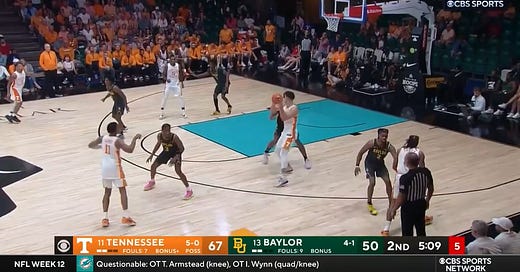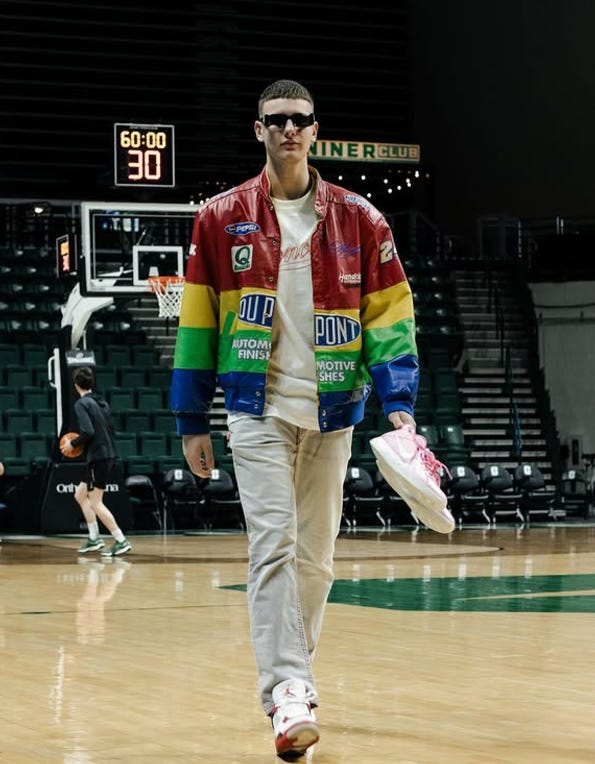Tennessee’s defense is good again. Obviously. This carries the same weight as such statements as “water is wet,” “Steph Curry is a good shooter,” and “hot dogs have questionable production quality but are an undeniably good food if prepared correctly.” Right now, it is nationally ranked as somewhere around a tie for first place (EvanMiya), second (Torvik, KenPom), third (Torvik, but with preseason priors removed), fourth (Haslametrics), or fifth (CBB Analytics). As of now, this will be Tennessee’s fifth-straight top-5 defense and their sixth top-10 defense in eight years.
That part is no surprise. Six of Tennessee’s seven opponents have been held below 0.95 PPP, and when the number to beat is Baylor’s 1.01 PPP - which would’ve been Baylor’s eighth-worst number in 2023-24 - they are probably pretty good, like usual. Tennessee is more or less always excellent on that end, occasional flubs notwithstanding.
Less common across the modern history of Tennessee basketball is this.
These are the offensive stats - overall efficiency, the Four Factors, and 2PT/3PT percentages - from Tennessee’s first eight games. Two of them were even against top-40 opponents. At KenPom, it roughly rates out as a national-average schedule so far, which makes sense. Two very good opponents, a couple of competent ones, and then four tomato cans. So you adjust for opponent quality, as Torvik does, and it produces this list of schedule-adjusted offensive performances.
Altogether, I have a list of stats for you.
This is Tennessee’s first time posting any stretch of eight straight games with 1+ PPP since 2018-19.
This is also Tennessee’s first time posting eight straight games of 1+ PPP to begin the season since 2000-21, or 24 years ago.
This is Tennessee’s first time ever posting seven outings of 50%+ from two in their first eight games.
At eighth nationally on KenPom, this is Tennessee’s first time ranking inside the KenPom top 10 offenses a month in…ever.
Three of Tennessee’s 50 best opponent-adjusted performances (Baylor, APSU, Syracuse) since 2007 have come in the first eight games.
Lastly: Tennessee has six games with a 1.1+ PPP, a 55% or better hit rate from two, and a 33%+ OREB%. Last season, with Dalton Knecht, they had five. In 36 tries.
What all of this means is that Tennessee’s offense is probably pretty good. Over the last 10 years, of the 100 top-10 offenses one month into a given season, 56 of 100 finished top-10. 86% at least finished top 25. This is not nothing, obviously, and considering the average offense gets better throughout the course of a season, Tennessee’s current schedule-adjusted efficiency of 120.6 points per 100 possessions - their second-best in program history - may well hold.
This is quite important, because we already know Tennessee’s going to show up on defense. We haven’t often seen the offense hold up their end of the deal. This is all without Dalton Knecht, now starting for the Lakers. It’s also without four-year starters Josiah-Jordan James and Santiago Vescovi. Tennessee had to rework their roster on the fly, adding four transfers and coming up with a new starting lineup where Zakai Zeigler is the only returning starter.
So: what’s fundamentally different? On the surface, not a ton. Zakai Zeigler is putting up better numbers than last year (117 ORtg/24% USG versus 111 ORtg/22% USG), but nothing astonishing. They’re getting less offensive production at center from the combo of Felix Okpara/Cade Phillips than they did from Tobe Awaka/Jonas Aidoo a year ago. Jahmai Mashack is, shockingly, Jahmai Mashack: an elite defender that doesn’t shoot often offensively. Chaz Lanier has had a bonkers start offensively but in terms of pure production, he’s more or less right where Knecht was.
There is one fundamental difference, at power forward, where the all-around production is several levels ahead of where it was last year, and frankly, where it’s been for several years. It is named IGOR.
Sorry, wrong IGOR. This one.
Igor Milicic Jr. arrived from Charlotte, where he was the best all-around player on a surprising 49ers team that went from preseason afterthought to 13-5 AAC team behind his two-way play. This offseason, he transferred to Tennessee to form a new frontcourt with Felix Okpara. I wondered a little bit how a frontcourt with two 6’10”+ guys would hold up, even if one of them had taken more threes than twos in his college career.
So far, it’s been a huge boon. Tennessee has its highest point production from the PF spot since 2018-19 and its most offensive rebounds since 2013-14, per KenPom. The first piece makes sense, because Milicic is arguably Tennessee’s first true ‘stretch big’ since 2018-19 Grant Williams. The intriguing aspect of this is that Milicic is a better shooter than Williams was in college and is three inches taller. It’s hard to imagine 2019 Williams letting a shot like this rip with such ease, for instance.
Tennessee hasn’t really had a 4, or even an occasional 5, quite like Igor before. He’s not the leading scorer, but he’s the most impactful player on the team. Every single player in the rotation is more efficient and impactful when he’s on the court, per Hoop-Explorer. With his shot diet, Tennessee is tracking to post their best 2PT% ranking in school history and is taking fewer midrange twos than ever before. Is Igor the key to…everything? If so: watch out.
BEHIND THE WALL ($): The coach’s son that plays like the ideal coach’s son







